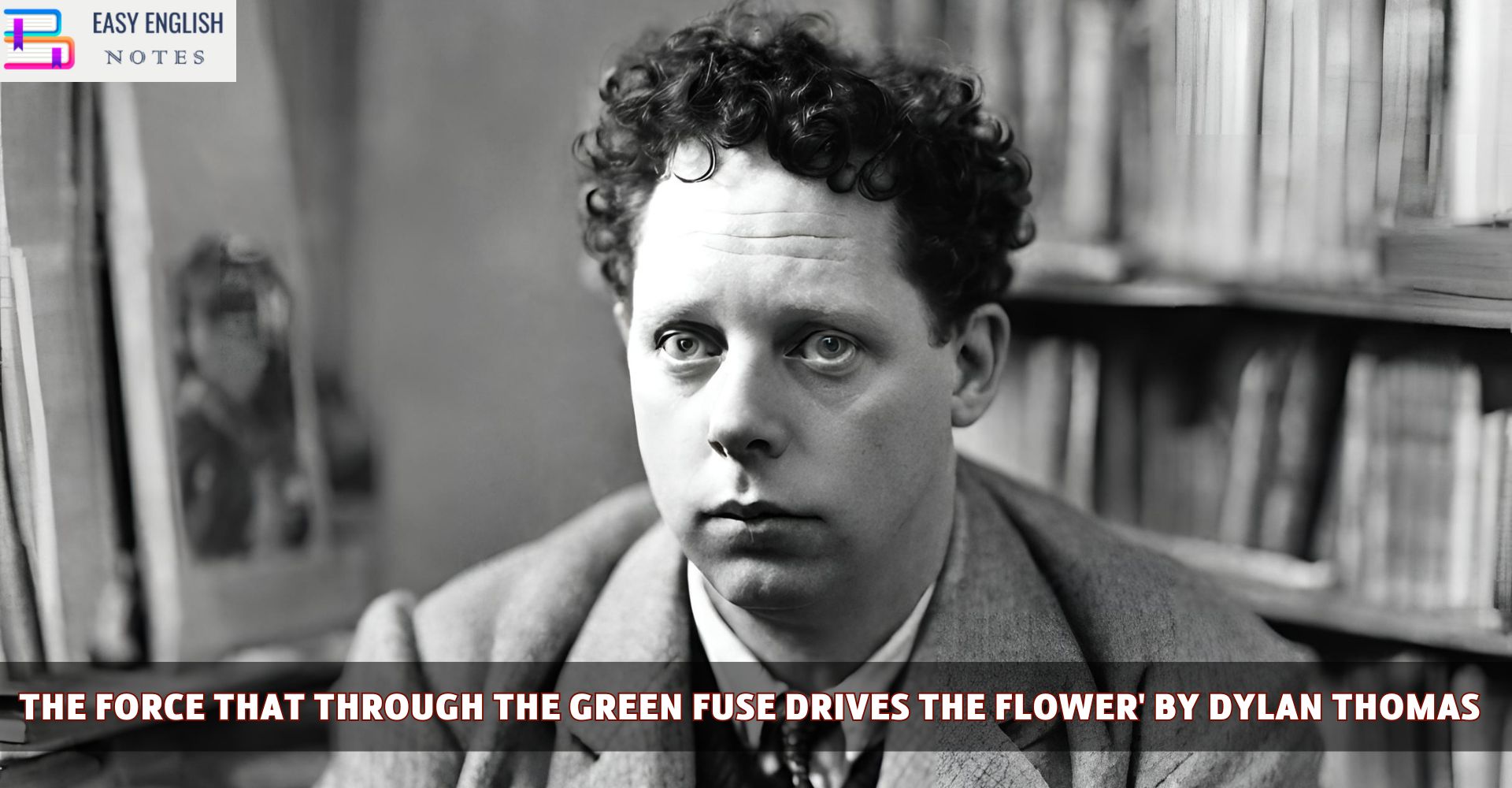“The Force that through the Green Fuse Drives the Flower” by Dylan Thomas is a compelling and complex poem, illustrating his profound contemplation of the interconnectedness of life and death, and the cyclical nature of existence. Written early in his career, this poem showcases the distinctive style and thematic depth that would come to characterize Thomas’s work.
Present poem is one of the best lyrics of Dylan Thomas. The lyric contains four of five lines. The poem first appeared in The Sunday Refree and Dylan Thomas won the prize and popularity when the poet was only nineteen years old.
The poet wants to say that the world ‘force’ has been used for both the world of Nature and the human body. The human body is somehow mysteriously the same as the whole world. The natural force at work is the one who are also at work in the other. The term ‘fute’. ‘the driving’ and “the blessing’ are mechanical. The operation of the poem in this way to be the kind of operations that men have to undertake in order to keep nature under control. Perhaps even to destroy her even though it is the life force itself which is given this power. The supreme force which makes the flower bloom also nourishes the poet’s youth. The force that explodes the roots of the tree is that which works up the ruin of the poet. The poet is dumb founded by the enormous destructive power of the force which has caused the withering away of the rose as well as the robbing of youth by means of the destructive agent that is wintry fever. The poet has used a series of symbols to move his lyrics forwards. Throughout the poem the force is personified as both benevolent and malevolent. Green is the symbol of youth, fuse is the symbol of mechanical operation of the force. Wax is the symbol of loss of potency and youth quick sand is a symbol of destruction as in the whirlpool and shroud sail is a complex symbol associated with birth and death. There are sexual imagery in the words ‘crooked’ and ‘bent’. These words suggest male sexual organs.
Also Read :
- Compare Hamlet with Macbeth, Othello and other Tragedies
- “The Pardoner’s Tale” is the finest tale of Chaucer
- Prologue to Canterbury Tales – (Short Ques & Ans)
- Confessional Poetry – Definition & meaning
- Line By Line Explanation Of The Poem The Eve of St. Agnes
Form and Structure:
- The poem consists of five quatrains, each following an ABAB rhyme scheme. This regular structure creates a rhythmic and musical flow, which is characteristic of Thomas’s poetry.
- The tightly woven structure serves as a counterpoint to the expansive and intricate imagery within the poem, reflecting the intricate interplay between life and death.
Themes and Ideas:
- Interconnectedness of Life and Death: The primary theme of the poem is the inseparable relationship between life and death. Thomas explores the idea that the same force that drives growth and vitality also leads to decay and destruction.
- Nature and the Human Condition: The poem draws a parallel between the natural world and human experiences. Thomas uses natural imagery to delve into human emotions, particularly the struggle to understand and accept the inevitability of mortality.
- The Cycle of Existence: There is a cyclical motif running through the poem, emphasizing the continuous and interconnected cycle of life and death. Thomas suggests that this cycle is a fundamental aspect of the natural world and human existence.
Imagery and Language:
- Thomas is known for his rich, vivid imagery, and this poem is no exception. The imagery is both powerful and evocative, painting a picture of the natural world that is full of energy and movement.
- The language is dense and often complex, with Thomas employing a variety of literary devices such as metaphor, simile, and personification to convey his themes.
Symbolism and Metaphor:
- The poem is rich in symbolism and metaphor. The “green fuse” is a central metaphor, symbolizing the life force that drives growth in nature and, by extension, human life.
- There are also numerous references to elements of the natural world – flowers, water, stones, and the wind – each serving as a metaphor for different aspects of life and death.
Tone and Mood:
- The tone of the poem is contemplative and introspective, with an undercurrent of awe and perhaps a tinge of despair. Thomas’s awe for the beauty and mystery of life is matched by his acknowledgment of the inevitability of death.
- The mood is one of wonder mixed with a sense of melancholy, reflecting the poet’s complex feelings about the cycle of life and death.
Critical Reception:
- “The Force that through the Green Fuse Drives the Flower” is widely regarded as one of Dylan Thomas’s most important and skillfully crafted poems. Critics have praised its lyrical quality, its deep philosophical themes, and its intricate use of imagery and language.
- The poem is often analyzed for its exploration of universal themes through the lens of the natural world, showcasing Thomas’s ability to find profound significance in everyday phenomena.
Conclusion:
This poem stands as a testament to Dylan Thomas’s poetic genius, encapsulating his ability to weave complex imagery and themes into a coherent and deeply moving exploration of life, death, and the natural world. “The Force that through the Green Fuse Drives the Flower” remains a significant work in the canon of 20th-century poetry, offering a timeless meditation on the fundamental aspects of human existence.











